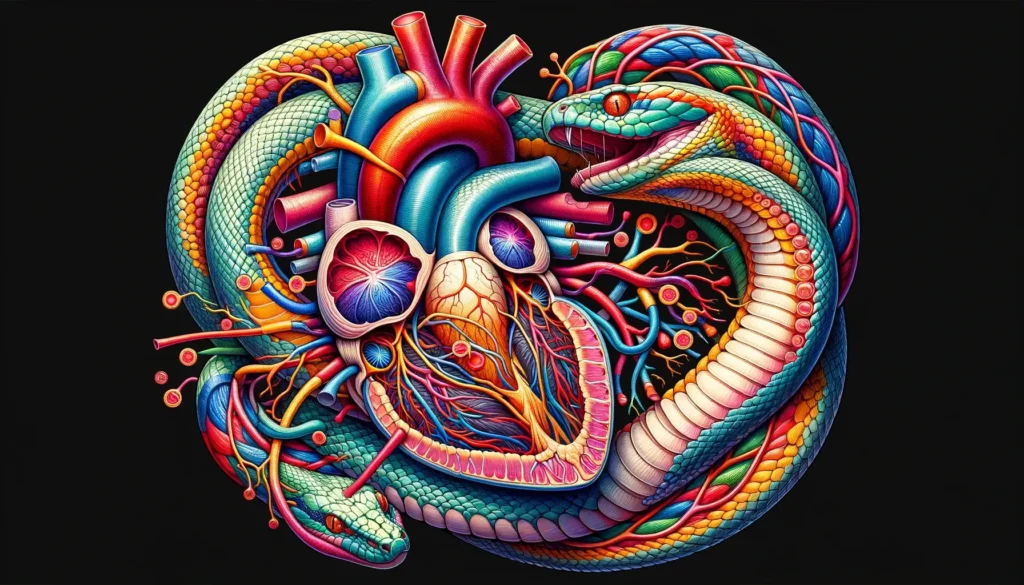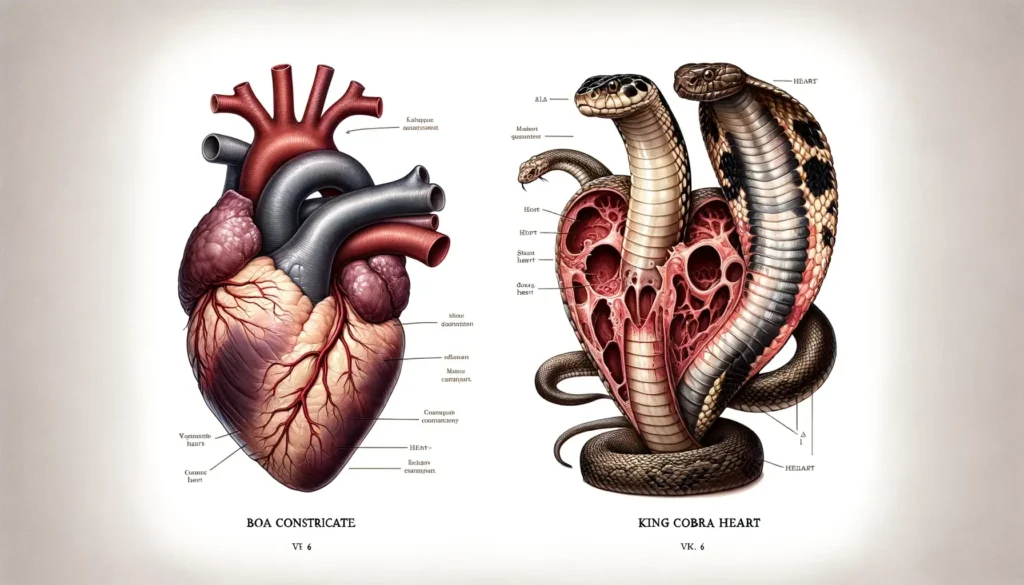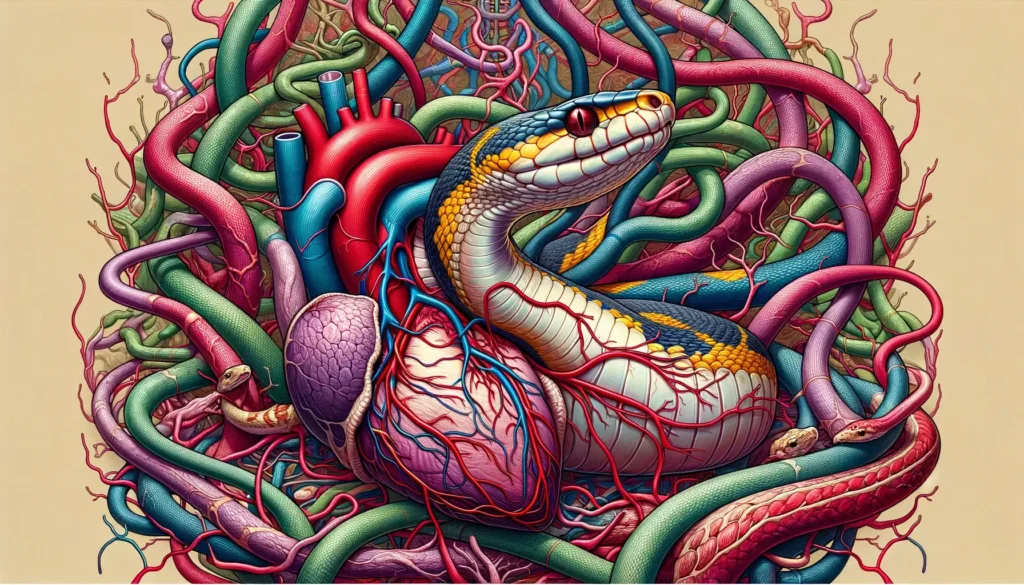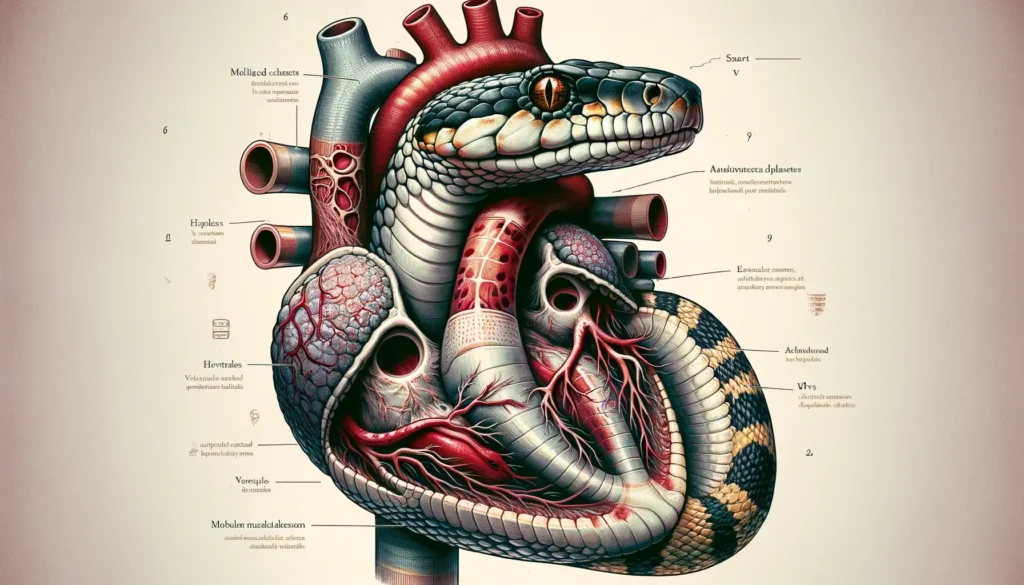Do you know the saying, “Cold-blooded but not cold-hearted”? When it comes to snakes, have you ever wondered if they actually have a heart? The mystery of snake anatomy goes deeper than meets the eye, and understanding their cardiovascular system might surprise you. From the unique structure of a snake’s heart to how it compares to other animals, the world of snake anatomy is a fascinating realm waiting to be explored.
Snake Cardiovascular System Overview
In a snake’s cardiovascular system, the intricate network of blood vessels and structures efficiently transports oxygen and nutrients throughout the body. Snakes have a heart, but unlike mammals and birds, they are not chambered. Instead, snakes possess a three-chambered heart with two atria and one ventricle. This unique structure allows for a slightly less efficient separation of oxygenated and deoxygenated blood than mammals with four-chambered hearts. However, snakes have adapted to this through specialized blood vessels and organs that aid in maintaining proper oxygen levels in their bodies.

Snakes have evolved various mechanisms to compensate for this difference despite not having a four-chambered heart. For instance, they have a highly efficient respiratory system that ensures oxygen is absorbed quickly into the bloodstream. Additionally, the unique anatomy of a snake’s heart allows for efficient blood circulation, enabling these fascinating creatures to thrive in diverse environments.
Anatomy of a Snake’s Heart
Snake’s three-chambered heart structure provides unique adaptations for efficient blood circulation and oxygen transport throughout their bodies. Unlike mammals with four-chambered hearts, snakes have two atria and one ventricle. This setup allows for a partial separation of oxygen-rich and oxygen-poor blood, improving overall circulation.

The right atrium receives deoxygenated blood from the body and pumps it into the ventricle. Simultaneously, the left atrium receives oxygenated blood from the lungs and delivers it to the same ventricle. Mixing oxygenated and deoxygenated blood in the ventricle is a key feature of snake anatomy.
From the ventricle, blood is pumped out to the rest of the body, where oxygen is delivered to tissues and organs. This process is less efficient than in mammals, but snakes have adapted to this limitation. Despite their unique heart structure, snakes have adapted well to their environment, showcasing the incredible diversity of nature’s solutions to biological challenges.
Comparing Snake Hearts
Comparatively, the cardiovascular system in snakes showcases distinctive adaptations in heart structure when contrasted with other vertebrates. Snakes possess a three-chambered heart, unlike mammals and birds, which typically have four chambers. This unique heart structure in snakes consists of two atria and one ventricle. The ventricle is partially divided into two compartments by a septum, allowing for some separation of oxygenated and deoxygenated blood. This adaptation is crucial for snakes as it helps optimize their circulatory system for their specific physiological needs.

Additionally, the atria in snake hearts are relatively larger than the ventricle, which aids in accommodating the varying blood flow rates during different stages of the snake’s movement and digestion. The anatomy of a snake’s heart allows for efficient circulation and blood oxygenation throughout the body. Understanding these adaptations provides insight into how snakes have evolved to thrive in diverse environments and exhibit remarkable survival skills.
Blood Circulation in Snakes
Snakes’ unique cardiovascular anatomy facilitates efficient blood circulation throughout their bodies, showcasing specialized adaptations for their physiological requirements.

Double Circulatory System: Snakes have a double circulatory system, similar to mammals, where blood is pumped twice through the heart for each complete circuit of the body, ensuring efficient oxygenation of tissues.
Low Resting Metabolic Rate: Due to their ectothermic nature, snakes have a lower resting metabolic rate than endothermic animals, influencing their blood circulation patterns and overall energy requirements.
Venom Delivery: In venomous snakes, specialized adaptations in blood circulation aid in the rapid delivery of venom to their prey or predators, ensuring swift immobilization or defense mechanisms.
This intricate network of blood vessels, heart structures, and metabolic adaptations in snakes allows for precise control over circulation, catering to their unique physiological demands. Understanding snakes’ blood circulation nuances provides valuable insights into their remarkable survival strategies and evolutionary adaptations.
Evolutionary Adaptations in Snake Hearts

Investigating the evolutionary adaptations of snake hearts reveals intricate structural modifications that optimize cardiac function for their unique physiological requirements. Snakes have undergone significant changes in heart structure throughout evolution to suit their specialized needs. One key adaptation is the elongation of the ventricle, which allows for increased blood flow during the rapid expansion of their bodies when feeding. This elongation facilitates the efficient delivery of oxygen and nutrients to muscles during digestion. Additionally, snakes have a highly muscularized heart, enabling powerful contractions to pump blood effectively through their long and slender bodies. Multiple aortas in some snake species further enhance blood distribution to various organs, compensating for the elongated body shape. These evolutionary adaptations in snake hearts showcase the remarkable ability of organisms to tailor their anatomical features to specific environmental and physiological demands, emphasizing the intricate relationship between form and function in evolutionary biology.

